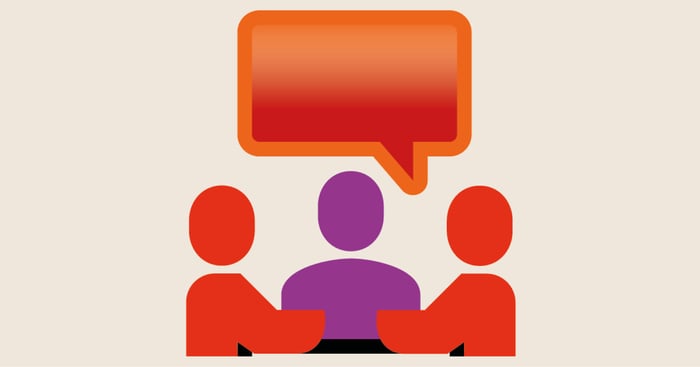Social dialogue has traditionally focused on socio-economic hardware topics. Thus, typical topics on the agenda are purchasing power and labor costs. This is an area where conflicting employer / employee interests are often sharply delineated. Newer issues on the agenda of social dialogue are sustainable careers, workable work, competencies of the future, innovative labor organization, ... These issues clearly require more creativity and a different set of dialogue skills. Addressing both types in the same way at the negotiation table, would be a missed opportunity.
Employee participation barometer
Results from the Participation Barometer 2021 (an initiative of SD Worx, AMS and Jobat) show that still more than half of the respondents think that the management and employee logic within their organization are at odds with one another. Moreover, 52% believe that action often prevails over dialogue. Conflict thinking is still very much alive within Belgian organizations.
At the same time, 68% say they are happy to engage in consultation and participation. The logics may be at odd, but that does not seem to get in the way of a lively 'voice' culture, which opens up opportunities. Especially when considering that there is still employee silence on numerous issues today.

Employee silence
"Even though I have good ideas about work, I don't put them forward." 38% confirm this statement. Flemish employees keep silent mainly because they don’t want to make a fuss about things that could interfere with the organization’s smooth operation. They don’t want to slow things down and are being empathetic. Another common reason is that employees find it difficult to give negative feedback. They feel they are lacking feedback skills and hence prefer to keep silent. Or they have all together given up hope of making an impact.
According to SD Worx, employee silence and participation are not mutually exclusive:
"Employers should stimulate employee participation in a targeted manner. One proven method is to actively delve into those topics that employees don’t communicate about, such as work distribution or employee-manager issues, coworkers, and tools for participation. Especially for organizations with 50-500 employees, now is the time to invest in dialogue and feedback skills. Giving effective feedback is an art, both in individual relationships and, for example, in social dialogue"
Jan Vanthournout (SD Worx)
Issues we keep silent about
Having a closer look at the issues that employees often keep silent about, it is striking to see that these are mainly HR-related, such as, e.g., workload. Workload does not only pop up in the survey as a possible cause of silence ("I don't have time to voice my opinion and even if I did, who would have time to put my ideas into action?") but also as a (sensitive) issue in itself that employees tend to remain silent about. By extension, work organization is often on the ‘silence menu’ as well. Employees don’t always believe the work organization is fair, but they find it difficult to communicate about this. Thus, it sometimes happens that they are assigned certain tasks without being able to express their feelings about this. In this way, changes in job or organizational design don’t always go down very well.
Reassessment
To break employee silence on these issues, the agenda of social dialogue needs to be reassessed. Social dialogue should no longer be exclusively about money but also about the content and the meaningfulness of sustainable jobs and sustainable careers. However, this requires that social dialogue is based on a model of partnership rather than conflict, and that it covers a broader range of topics, more than is the case today.
Talking about workload
Let's look at the example of workload. Rebalancing workload is evidently a domain of shared ownership and leadership. While problems often are the subject of a spontaneous animated debate, this is not the case when it comes to finding solutions. Nevertheless, working together and talking about solutions to workload, nurtures solidarity and empathy and hampers the development of an indifferent and negative attitude.
Therefore, you could, e.g., systematically put the issue on the agenda at company level during the weekly team meetings or at the CPPW (Committee for Prevention and Protection at Work). Thus, the issue is being closely monitored, and it is also perceived that way by employees. In a constructive and creative search for solutions, it is particularly important to create a dynamic environment. An environment in which formal and informal consultation and direct and indirect participation go hand in hand.
Win-win
Workload dialogues are partnership dialogues par excellence. The partnership strategy seeks a win-win situation for both company and employee. It is key that employees are willing to keep the company's interests in mind and, vice versa, that management takes the employees' interests into account. Within such a partnership mindset, contradiction takes on a completely different character. Mutual dependence is respected, and one reacts to each other in an appreciative and supportive way, while there is also room for mutual critical feedback. This is even stimulated and facilitated. A mutual effort toward critical friendship, so to speak.
10 blog posts for 10 years of Next Generation Work
This blog post is the eight in a series of 10. In each blog post we will offer solutions from different perspectives, as a count down to November 2021, the moment when we bring everything together in the celebration of 10 years of Next Generation Work. We already look forward to welcoming you there. More information will follow in the next few months.




